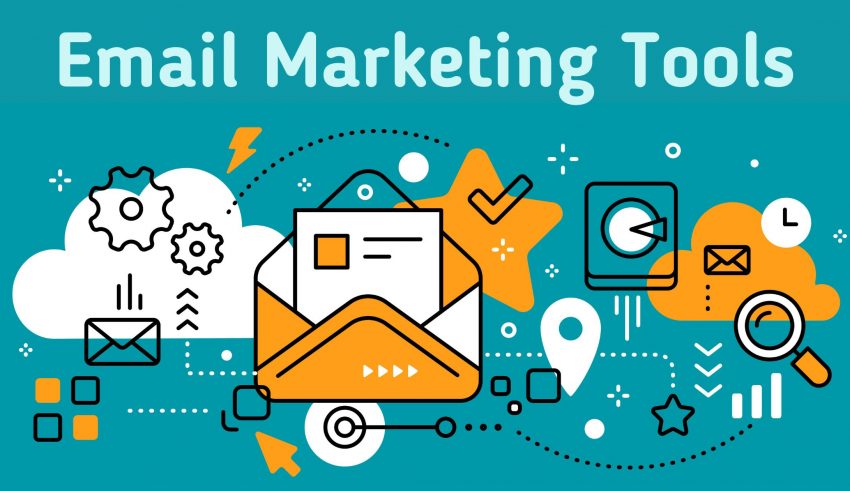Reach Your Audience with These Email Marketing Tools
Introduction Of Email Marketing Tools
Email marketing tools are software solutions designed to help businesses create, send, and track email campaigns. These tools provide a range of features and functionality to make it easier for businesses to connect with their customers via email.
The following are some frequent features of email marketing tools:
Email templates:
pre-designed email templates that organizations may use to quickly and easily create professional-looking emails.
Email automation:
Tools that allow businesses to automate their email campaigns, such as welcome emails, abandoned cart reminders, and post-purchase follow-ups.
Contact management:
features that allow businesses to manage their email lists and subscriber information.
A/B testing:
functionality that enables businesses to test different email designs, subject lines, and content to see what resonates best with their audience.
Analytics:
tools that provide data and insights into how email campaigns are performing, including open rates, click-through rates, and conversions.
Email Marketing Fundamentals
Email marketing is a powerful tool that allows businesses to communicate with their customers directly through their email inboxes.
Build a Quality Email List:
People who have opted in to receive your emails should be on your email list. This ensures that your emails go to people interested in hearing from you.
Segment Your List:
You can divide your email list into segments based on demographics, purchase history, or other criteria. This allows you to create more targeted and personalized campaigns.
Create Engaging Content:
Your emails should be visually appealing and include interesting and relevant content that is valuable to your subscribers. Use images, videos, and clear calls to action to keep your subscribers engaged.
Use an Effective Subject Line:
Your subject line should be attention-grabbing and give your subscribers an idea of what to expect in the email.
Make It Mobile-Friendly:
A large percentage of people read their emails on mobile devices, so make sure your emails are optimized for mobile.
Test and Optimize:
Experiment with various email templates, subject lines, and content to see what works best for your target audience. Track the success of your efforts using data and analytics and make adjustments as needed.
Follow Email Marketing Laws:
Ensure that you are following email marketing laws, such as including an opt-out link and honoring opt-out requests promptly.
Types of Email Marketing Tools
There are many different types of email marketing tools available to businesses.
Email Service Providers (ESPs):
ESPs are platforms that allow businesses to send and manage email campaigns.
Marketing Automation Platforms:
These platforms provide businesses with the ability to automate their email campaigns, such as welcome emails, abandoned cart reminders, and post-purchase follow-ups. Examples include HubSpot, Marketo, and Pardot.
CRM Email Marketing Tools:
These tools are integrated with a business’s CRM (Customer Relationship Management) system and allow businesses to send targeted and personalized emails based on customer data. Examples include Salesforce Marketing Cloud and Zoho Campaigns.
Email Verification Tools:
These tools help businesses ensure the quality of their email lists by verifying email addresses and removing invalid ones. Examples include ZeroBounce and NeverBounce.
Email Design Tools:
These tools provide businesses with pre-designed email templates and drag-and-drop editors to create professional-looking emails quickly and easily. Examples include Canva and BEE Free.
Email Analytics Tools:
These tools provide businesses with data and insights into how their email campaigns are performing, including open rates, click-through rates, and conversions. Examples include Google Analytics and Sendinblue.
Choosing the Right Email Marketing Tools
Choosing the right email marketing tool is essential to the success of your email marketing campaigns.
Features:
Look for an email marketing tool that offers the features you need to create effective email campaigns. This may include automation, segmentation, analytics, A/B testing, and mobile optimization.
Ease of Use:
Consider how easy the platform is to use. Look for a tool with a user-friendly interface and drag-and-drop editors to make it easy to create emails.
Integrations:
Check if the tool integrates with other marketing tools or CRMs that you use. This will make it easier to manage your email marketing alongside your other marketing efforts.
Deliverability:
The ability to deliver emails to the inbox of your subscribers is critical. Look for a tool with reasonable deliverability rates and email verification features to keep your email list clean and reduce bounces.
Pricing:
Consider your budget and choose a tool that offers a pricing plan that fits within it. Look for a device that offers flexible pricing plans based on the number of subscribers or emails sent.
Support:
Look for a tool that provides excellent customer support, including email, chat, or phone support, and a knowledge base or community forum.
Integration and Compatibility
Integration with other tools:
Look for an email marketing tool that integrates with other marketing tools or CRMs you use, such as social media management platforms, landing page builders, and customer relationship management software. This will allow you to streamline your marketing efforts and easily manage your email campaigns alongside your other marketing activities.
Compatibility with your website and other platforms:
Ensure that the email marketing tool you choose is compatible with your website and other platforms you use. For example, if you use WordPress as your website platform, make sure the email marketing tool you choose has a WordPress plugin available.
API availability:
Check if the email marketing tool provides an API (Application Programming Interface) that allows developers to integrate it with other software applications.
Data synchronization:
Ensure that the email marketing tool synchronizes your subscriber data with your CRM or other marketing tools automatically. This will ensure that your subscriber data is always up-to-date and accurate.
Third-party integrations:
Check if the email marketing tool provides integrations with third-party applications such as Zapier or IFTTT. These integrations can expand the functionality of your email marketing tool and allow you to automate tasks and workflows.
Tips for Successful Email Marketing Campaigns
Build a quality email list:
Focus on building an email list of engaged subscribers who have opted-in to receive your emails. This will ensure that your emails are delivered to a receptive audience and increase the chances of engagement and conversion.
Personalize your emails:
Make your emails more relevant to your readers by using customization. This can include using their name, segmenting your list based on interests, or sending targeted offers based on their behavior.
Use compelling subject lines:
Write subject lines that grab the attention of your subscribers and entice them to open your emails. Make sure your subject line is clear, and concise, and highlights the value of your email.
Keep your content relevant and engaging:
Provide your subscribers with content that is informative, relevant, and valuable to them. Use clear and concise language and include images, videos, or infographics to make your content more engaging.
Use a clear call to action:
Include a clear call-to-action (CTA) in your emails that encourage your subscribers to take action. This could be to click a link, download an ebook, or make a purchase.
Test and optimize your campaigns:
Use A/B testing to experiment with different elements of your emails, such as subject lines, CTAs, or content. Analyze the findings and tailor your marketing to what works best.
Monitor your metrics:
Keep track of key metrics such as open rates, click-through rates, and conversions to understand how your campaigns are performing and identify areas for improvement.
Conclusion
In Conclusion, email marketing is an effective tool for businesses to engage with their customers, create relationships, and produce outcomes. With the right email marketing tools, businesses can create effective email campaigns that engage their subscribers, provide value, and ultimately grow their business. By considering factors such as features, ease of use, integration, compatibility, pricing, and support, businesses can choose an email marketing tool that meets their needs and helps them achieve their goals. By following best practices such as building a quality email list, personalizing emails, using compelling subject lines, providing engaging content, including a clear call-to-action, testing and optimizing campaigns, and monitoring metrics, businesses can create successful email marketing campaigns that drive results and build long-term relationships with their subscribers.
What are the best email marketing tools for small businesses?
Some of the best email marketing tools for small businesses include Mailchimp, Constant Contact, and Sendinblue. These tools offer features such as email automation, list management, and analytics to help small businesses create effective email campaigns.
How can email marketing tools help me grow my business?
Email marketing tools can help you grow your business by allowing you to connect with your audience, build relationships, and drive conversions. With features such as personalization, automation, and segmentation, you can create targeted campaigns that resonate with your subscribers and drive results.
What is the best way to build an email list for my business?
The best way to build an email list for your business is to offer value to your audience and make it easy for them to opt-in to receive your emails. This can include offering a lead magnet, running a contest, or providing exclusive content. You can also promote your email list on social media and your website to attract subscribers.
How can I measure the success of my email marketing campaigns?
You can measure the success of your email marketing campaigns by tracking metrics such as open rates, click-through rates, and conversions. By analyzing these metrics, you can identify areas for improvement and optimize your campaigns for better results.
Can email marketing tools improve my local SEO?
Yes, email marketing tools can improve your local SEO by allowing you to send targeted emails to subscribers in your local area, promoting your business and driving traffic to your website. Additionally, email marketing can help you generate reviews and feedback from local customers, which can boost your online reputation and improve your local SEO rankings.
How can email marketing tools help me increase customer engagement?
Email marketing tools can help you increase customer engagement by allowing you to create personalized and targeted campaigns that resonate with your audience. With features such as automation and segmentation, you can send emails that are relevant to your subscribers’ interests and behavior, encouraging them to interact with your business and take action.
Are there any local SEO best practices that can improve my email marketing campaigns?
Yes, there are several local SEO best practices that can improve your email marketing campaigns. For example, including location-based keywords in your subject lines and content can help your emails rank higher in local search results. Additionally, promoting local events or specials in your emails can attract local customers and boost your local SEO.
How often should I send emails to my subscribers?
The frequency of your email campaigns depends on your audience and your business goals. Generally, it’s recommended to send at least one email per month to stay top-of-mind with your subscribers. However, you should also consider the preferences and behavior of your audience and adjust your email frequency accordingly.
How can email marketing tools help me increase website traffic?
Email marketing tools can help you increase website traffic by including links to your website in your emails, promoting your blog content or products/services, and encouraging subscribers to visit your website. Additionally, you can use email campaigns to promote your social media profiles, which can also drive traffic to your website.
What are some common mistakes to avoid when using email marketing tools?
Common mistakes to avoid when using email marketing tools include sending too many emails, using vague or uninteresting subject lines, not personalizing emails, and not testing your campaigns before sending. It’s important to follow best practices and analyze the results of your campaigns to identify areas for improvement.
Contact us for More Services,
7) Chat Service
12) Video Designing
Contact Us
+91-9380797662
info@emazel.com
Author


